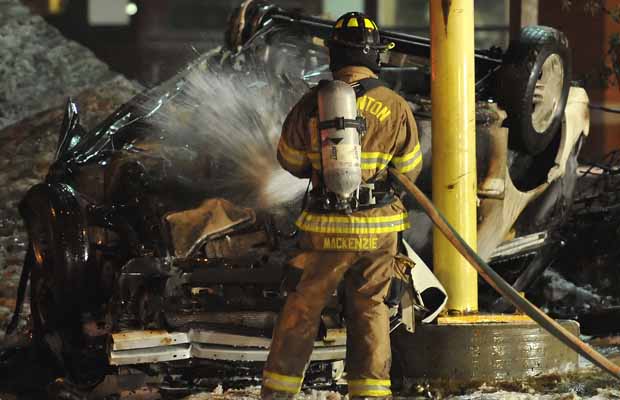EDMONTON – Next to Edmonton’s nation-leading homicide rate, it’s the most unusual policing statistic of 2011.

More than seven months into the year, there have been only 11 traffic fatalities on the city’s streets, compared with 28 and 32 a year over the last four years.
So far in August, there have been no traffic fatalities, compared with eight deaths in the same month in 2009 and six in 2010.
Staff Sgt. Barry Maron is just fine with homicide detectives getting all the headlines. But the former traffic investigator knows things can change quickly. In the past, he’s seen up to five fatalities in a single week.
“We’re holding our breath,” Maron said. “There’s no real way of predicting (fatalities). There’s any number of intersections in the city, any number of days of the week. There’s always potential for a fatality.”
The three main causes of Edmonton’s traffic deaths are pretty much a constant, Maron says: failing to wear seatbelts, jaywalking and speeding.
According to provincial statistics, about 92 per cent of Albertans wore their seatbelts in 2010. But a third of those killed in Edmonton traffic accidents in 2010 and half of those in 2009 weren’t wearing theirs.
Jaywalking is the main cause of pedestrian deaths. There have been five so far this year, close to the seven in 2010 and 10 in 2009.
- As Loblaw boycott begins, what to know about all the company’s brands
- Poilievre booted from House of Commons after calling Trudeau a ‘wacko’
- $34B Trans Mountain pipeline expansion project opens after years of construction
- N.S. man stuck abroad due to lack of available hospital beds ‘in our own province’
Speeding has been a major factor in 36 per cent of collisions this year, the same as in 2010 and down from 48 per cent in 2009.
But Maron isn’t pointing to any single reason for the drop. After all, statistics can cut both ways.
“What is it? It’s something that’s not quite tangible. You can’t put your finger on just why there are less fatalities. We’re just happy there are,” Maron said.
A number of programs might contribute to the lower total. Operation 24 – single-day ticket blitzes held since November 2008 – led to drops in collisions for a year and a half before levelling off. Curb the Danger, which encourages Edmontonians to call 911 to report impaired drivers, led to 441 impaired-driving charges in the first seven months of this year.
But results from those programs don’t easily translate into saved lives.
“You can’t say you’ve prevented a death,” Maron said. “But there’s a better-than-average chance that there are some people are alive today that wouldn’t be otherwise.”
Police haven’t been doing all that much differently this year, Maron said. In April, the force added a crew of six members to its traffic enforcement. And starting next month, provincial distracted-driver legislation takes effect, targeting use of electronic gadgets.
“We’re not going to jump on people immediately. However, we will be starting to enforce that legislation September 1st,” Maron said. “People need to start thinking about changing their habits when they’re driving.”
Distracted-driver legislation targets one of the most persistent challenges in traffic enforcement: convincing drivers their cars aren’t cocoons where it’s safe to eat, smoke, even read. Numerous safety features – heads-up displays, ABS brakes and quieter engines – actually feed this illusion, allowing drivers not to notice the road the way they did a couple of decades ago.
“Our brains are so magnificent that it creates this mask,” Maron said. “People forget they’re hurling down the road in a 3,000-pound piece of steel that potentially can take the life of someone else.”



Comments